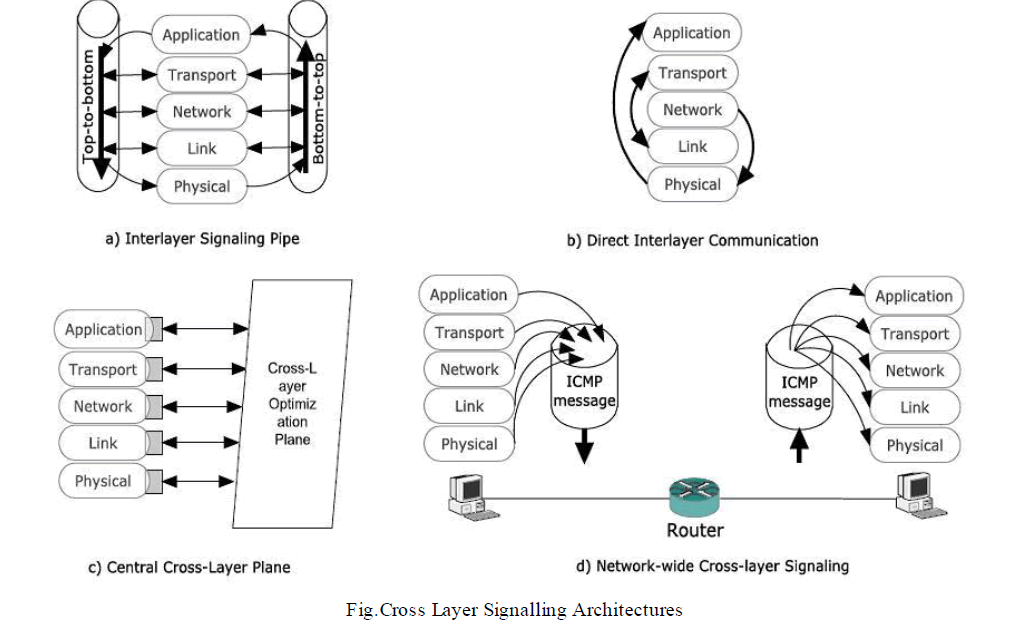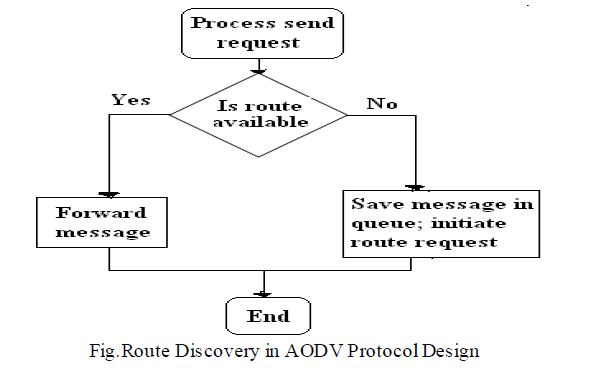ISSN ONLINE(2320-9801) PRINT (2320-9798)
ISSN ONLINE(2320-9801) PRINT (2320-9798)
Mazher Khan, Sheetal Bhale
|
| Related article at Pubmed, Scholar Google |
Visit for more related articles at International Journal of Innovative Research in Computer and Communication Engineering
MANETs are used to economically extend coverage & capacity of existing GSM,UMTS & Wi-Fi networks.Performance of MANET protocol AODV is studied by using cross -layer interaction between different layers e.g. among physical,MAC & network layer using Received Signal Strength as cross layer interaction parameter.Here we study different algorithms such as DSTC(Distributed Space Time Coding) and PA-PSO(Power Allocation-Part icle Swarm Optimisation).We get improvised throughput and effective capacity maximisation in the output.
KEYWORDS |
| MANET,AODV,CLD,RSS,EC,DSTC,PSO |
I. INTRODUCTION |
1.1 What is Cross-Layer Design? |
| In the Cross layer networking physical and MAC layer knowledge of the wireless medium is shared with higher layers,so as to provide efficient methods of allocating network resources and applications over the internet.Communicat ion system works with the concept of logical layers.[3]In the logical layers any one layer is unaware about the internal details of another layers.But this is not compatible to networks employing communication and access.Here in a model is proposed to work on co-optimized designs across protocol layers,which is termed as cross layer design |
1.2 Why cross layering? |
| Advantages of CLD will be energy conservation,unidirectional link rejection & reliable route information. While using Cross Layer networking physical and MAC layer knowledge of wireless medium is shared with higher layers so as to provide efficient methods of allocating network resources & applications over internet.Capacities offered through wireless LAN interface approach the level of capacity that can be handled over internet backbone. |
II. RELATED WORK |
| In[1] Effective Capacity is considered and is calculated.For this Quality of Service(QoS) parameter is taken into consideration.And for calculating and implement ing this effective capacity PA-PSO(Power Allocation-Particle Swarm Optimisation) algorithm is considered. And Effect ive capacity is maximised and outage probability is to be minimised.In [2] End to end delay is minimized by routing and link layer scheduling.End to end delay depends on two parameters mainly i)Length of route ii)Interference level along path.Here two cross layer schemes are proposed which are i)Loosely couples -In this first routing is done and then informat ion is sent over the path.i.e.2 models are used. ii)Tightly coupled-Here,both routing and information sending is done in one optimisation model itself.In[3] There are numeral proposals for cross layer designs and their corresponding architectures have been studied in the literature.These mainly depend on one of the basic categories mentioned.In this paper author emphasize in looking at cross-layering architectures in terms of how and where it gathers cross -layer and optimizat ion related informat ion.There are 2 possible architectures which are mentioned in this paper are: |
| (i)Architectures based on local information and(ii)Architectures based on local and global information.Also by using Received Signal Strength(RSS) from physical layer For selecting strong route in a MANET throughput,speed,capacity and potential performance gains can be increased.In[4] author has proposed a formula which shows the relationship between received power and transmitted power.For this i)Received Signal Strength(RSS) is used to compute the minimum sufficient transmit power to obtain energy conservat ion,interference reduction and spatial reuse.ii)RSS info is used to calculate path loss incurred in order to identify and reject unidirectional links which affect performance of AODV in heterogeneously powered network. |
 |
III. PROPOSED ALGORITHM |
| A. Design Considerations: |
| i)DSTC without cross layer |
| As the transmission delay increases it prevents the relay channel to support more arrival rate with given QoS constraint,which is equivalent to EC reduction.So as to overcome this problem physical layer technique is used which is nothing but the Distributed Space Time Coding(DSTC)Here,in this technique all relays are allowed to retransmit source signal to destination on single channel simultaneously.c |
| ii)PA-PSO without cross layer |
| In a mult irelay networks temporal power assignment leads to much overhead so a fixed cross layer PA algorithm is proposed which is done at destination node and needs statistical Channel State Information(CSI) and ̬̉.To use PSO in PA its validation should be evaluated.And the performance of applied PSO algorithm is reliable and correct. |
| We are going to compare the DSTC algorithm with and without using cross -layer.Similarly for PA-PSO algorithm results can be compared with and without using cross -layer. |
| B. Description of the Proposed Algorithm: |
| There are two phases while implementing AODV Protocol Design:1.Route Discovery2.Route Maintenance |
| AODV implementation is based on a recent draft of the AODV specification which includes following points: |
| i. RREQ and RREP mes sages(for route discovery) |
| ii. RERR messages,HELLO beacons and precursor lists(for Route maintenance) |
| iii. Sequence numbers |
| iv. Hop counts |
 |
| ii)Strong route selection |
| By using RSS from physical layer for selecting strong route in a AODV throughput,speed,capacity can be improved. RSS is used to calculate the minimum sufficient transmit power so as to get energy conservation,interference reduction & spatial reuse.[4] |
| RSS info is used to calculate path loss incurred in order to identify & reject unidirectional links which affect performance of AODV in heterogeneously powered network. |
| By using RSS info so as to choose reliable links to form stable routes by monitoring signal quality to judge whether neighbours are approaching or leaving. |
| Transmission power control is done for data packet alone for energy conservative CLD to save battery life. The relationship between transmission power and received power is given as |
| PR=PT{(λ/4πd)^2}GTGR |
| Where,λ |
| PR=Received Power |
| PT=transmission Power |
| λ=Wavelength of carrier |
| d=Distance between sender and receiver |
| GT=Unity gain of transmitting omni directional antennas |
| GR= Unity gain of receiving omni directional antennas |
| iii)Effective Capacity calculat ion |
| Effective capacity is defined as the maximum constant arrival rate that is supported by a wireless channel so that the Qos requirements are guaranteed.[1] |
| For an uncorrelated channel with a stationary and ergodic service process,EC is computed as follows: |
| Ec (Ãâè)=-1/θ{ ln(E(e ^-θC))} |
| Where, |
| Ec (̬̉)=Effective capacity function |
| ̬̉=QoS exponent |
| C=Instantaneous channel capacity |
IV. CONCLUSION AND FUTURE WORK |
| MANETs are used to economically extend coverage & capacity of existing GSM,UMTS & Wi-Fi networks.All this can be achieved by using Cross layer protocol interaction parameter.This helps in improvising capacity maximisation and increase in throughput of the given system.Past wireless networks had the problem of range,data rate;this can be reduced by using cross layer design |
| This paper shows implementation of cross layered designed in MANET through AODV Routing Protocol using Received Signal Strength(RSS).This is studied by using algorithms such as DSTC(Dist ributed Space Time Coding) a and PA-PSO(Power Allocation-Particle Swarm Optimisation) algorithm by comparing them with cross layer design and without cross layer design. |
References |
|